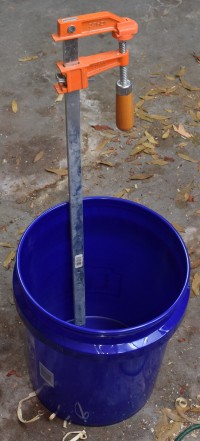I have been reading a set of books that are directed at teaching the old methods of design using simple tools and ratios. How did people build so many things and design such gorgeous furniture before industrial era tools and production? A lot of it had to do with ratios. They noticed basic ratios and proportions of the body, and used them to create furniture that fit our proportions and was decorated with ratios that are pleasing to the eye.
Getting ratios can be tough, but one tool helps a lot. The sector. I will start with a sector demonstration, then go through converting a ubiquitous folding ruler into a ratio tool.
SO! Say you have this nice block of wood, and want to divide it into 3rds for some reason. Instead of reaching for the fine ruler and calculator, take this pivoting stick with equal divisions on it and line both edges up on the 9s.

Now you take your divider, (it looks like a compass, but only has points, no pencil) and line it up with the 3 marks. The 3 to 9 ratio is also a 1:3 ratio. The dividers are now set at 1/3rd of the width of that piece of wood.

Line up one leg of the dividers with an edge of the wood and step in twice. You leave a little pin prick in the wood as you step over. Put a sharp pencil or marking knife in those divots left by the divider and use a square to transfer across the piece.

Bam! Divided into 3rds in no time. Find the center point of something in a snap, set drawer pulls up 4/7ths from the bottom of a drawer face, or divide an area up to figure out how wide a mitered framing should be. The possibilities are endless and require almost no math skills. Now you know how an early 18th century woodworker could divide something up with extreme precision even if their ruler had nothing finer than 1/4″ marks.
Sector Construction
You can build a sector out of any two straight pieces of wood or other material, and a tight hinge. I opted to start with a folding rule. There are plenty to be had on ebay for ~10 bucks, and they look really nice when cleaned up a bit. This one started with a lot of years of use, and a brass edge that was coming undone.

I sanded a mountain of nasty finish and imprinted lettering off before getting to clean bare wood. I fixed the splayed brass edge with epoxy and put a nice set of markings down. The divisions I used are arbitrary, but they must come from the center of the pivot point, and must be consistent across the sector.
All that hard work didn’t really matter though, because a coat of spray lacquer lifted the sharpie text and bled it everywhere. Now my lines are blurred beyond use.

Pro tip: Don't use spray lacquer over sharpie!
Rule #2 Conversion
Luckily I am addicted to buying old tools on ebay and purchased not one, but two folding rules! While the first one sits in time out, take another rule you haven’t ruined, sand it down, put equal marks on both sides, and use BOILED LINSEED OIL to finish it. It will look great.
I left the backside unchanged so I could have a basic ruler handy when using my sector.











































































